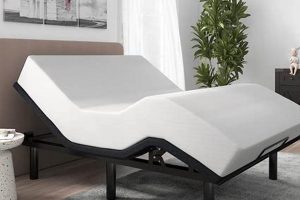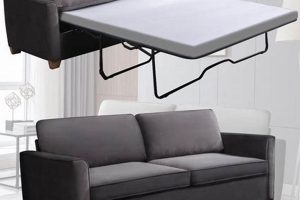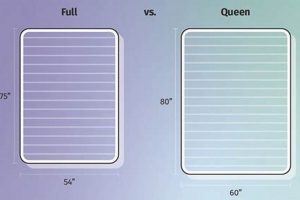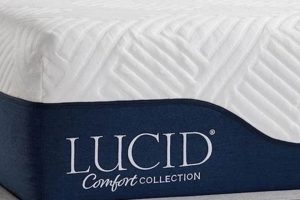The act of substituting the cushioning component of a convertible couch designed for two occupants is a relatively common household maintenance task. This typically involves removing the worn or damaged interior component and installing a new one of compatible dimensions and construction, ensuring the continued utility of the furniture piece. The size specifications are critical, requiring precise measurements to guarantee proper fit within the sofa bed frame.
Maintaining the condition of this particular bedding component enhances the overall comfort and support provided by the furniture. A deteriorated or inadequate interior can lead to discomfort during sleep, potentially affecting spinal alignment and rest quality. Replacing this element can extend the lifespan of the sofa bed, preventing the need for complete furniture replacement and representing a more economical solution. Historically, the ability to easily exchange components of furniture has contributed to sustainability efforts by reducing waste.
The following sections will delve into the various types of available options, factors influencing the selection process, installation procedures, and essential maintenance practices to ensure longevity and optimal performance. Understanding these aspects empowers consumers to make informed decisions and effectively manage this element of home furnishing upkeep.
Essential Guidance for Replacements
The following recommendations offer practical advice for ensuring a successful exchange, promoting both comfort and longevity.
Tip 1: Precise Measurement is Paramount. Before acquiring a new component, carefully measure the internal dimensions of the sofa bed frame. Inaccurate measurements may result in a mismatched fit, rendering the new interior unusable. Consult the manufacturer’s specifications, if available, for optimal sizing guidance.
Tip 2: Evaluate Material Composition. Different materials offer varying degrees of support and durability. Options range from traditional innerspring designs to memory foam and latex. Consider the intended frequency of use and preferred firmness level when selecting the material composition. For example, frequent use might necessitate a more resilient material like high-density foam.
Tip 3: Assess Thickness Considerations. The thickness influences comfort and the ability of the sofa bed to properly fold. A too-thick component can impede folding functionality, while a too-thin one may provide insufficient support. Adhere to the recommended thickness range specified by the sofa bed manufacturer.
Tip 4: Prioritize Quality Certification. Seek replacements that possess certifications such as CertiPUR-US. These certifications indicate that the materials have been tested for harmful substances and meet specific standards for content, emissions, and durability. This ensures both safety and quality.
Tip 5: Consider Protective Covering. Implementing a protective covering safeguards the newly installed item from stains, spills, and general wear and tear. A waterproof or stain-resistant cover extends its lifespan and simplifies cleaning procedures. Select a covering specifically designed for sofa bed configurations.
Tip 6: Inspect Support Mechanisms. Prior to installation, carefully inspect the sofa bed frames support mechanisms, including the springs and metal frame. Address any existing damage or weaknesses to prevent premature wear and tear on the new cushioning component. Repairing or reinforcing these mechanisms ensures adequate support and prevents sagging.
These guidelines offer a structured approach to successfully replace the component, ensuring enhanced comfort, durability, and overall functionality.
The subsequent sections will explore the installation process and ongoing maintenance procedures for optimal performance.
1. Size Compatibility
Size compatibility is a foundational element in the successful replacement of a sofa bed’s cushioning component. A mismatch in dimensions can negate the intended benefits of the replacement, leading to functional issues and compromised comfort.
- Accurate Measurement and Frame Integration
Precise measurement of the sofa bed frame’s internal dimensions is paramount. The replacement must correspond exactly to these measurements to ensure proper integration. A component that is too large will not fit within the frame, while one that is too small will shift and provide inadequate support. Incompatibility can also damage the folding mechanism.
- Thickness and Folding Mechanism Alignment
Thickness is a critical dimension affecting the sofa bed’s ability to fold and unfold smoothly. An inappropriately thick component will exert undue stress on the folding mechanism, potentially causing damage. Conversely, a component that is too thin may not provide sufficient cushioning, resulting in an uncomfortable sleep surface. The selected item must align with the manufacturer’s specifications for optimal functionality.
- Edge-to-Edge Support and Sag Prevention
Proper size compatibility ensures edge-to-edge support across the entire sleeping surface. If the component is too narrow or short, gaps may form along the edges, leading to sagging and uneven weight distribution. This can create pressure points and compromise spinal alignment, resulting in discomfort and potential long-term health implications.
- Standard vs. Non-Standard Sizes and Custom Solutions
While some sofa beds adhere to standard size dimensions, others may utilize non-standard or proprietary sizes. In cases where a standard size does not suffice, custom solutions may be necessary. This involves commissioning a component tailored to the specific dimensions of the sofa bed frame. Failure to address non-standard sizing can lead to a poorly fitting replacement and compromised performance.
Ultimately, achieving size compatibility is essential for optimizing the performance and lifespan of a sofa bed’s cushioning component. Careful attention to measurement, thickness, and support considerations ensures that the new component integrates seamlessly with the existing frame, providing a comfortable and functional sleeping surface.
2. Material durability
Material durability stands as a critical factor directly influencing the lifecycle and performance of a sofa bed’s cushioning element. The cause-and-effect relationship is evident: robust materials withstand prolonged use, while inferior materials degrade rapidly, necessitating more frequent replacements. The inherent ability of a material to resist wear, compression, and degradation under repeated stress directly determines its suitability for this application. For instance, a high-density foam construction will demonstrably maintain its shape and support over time compared to a low-density alternative, which is more prone to sagging and compression after repeated use. Choosing a durable material represents an investment in longevity and sustained comfort.
The practical significance of understanding material durability extends beyond initial cost considerations. While less durable options may present a lower initial price point, their shorter lifespan leads to increased replacement frequency, ultimately incurring higher long-term expenses. Conversely, a more durable option, such as a latex construction, offers resistance to dust mites and allergens, providing a healthier sleep environment and reducing the need for frequent cleaning or replacement due to hygiene concerns. Furthermore, the selection of durable, sustainably sourced materials contributes to environmentally responsible practices by minimizing waste associated with frequent replacements.
In conclusion, material durability is an essential determinant of a sofa bed’s cushioning component’s long-term performance and cost-effectiveness. Selecting robust materials, despite a potentially higher upfront investment, minimizes replacement frequency, ensures sustained comfort and support, promotes hygiene, and contributes to environmental sustainability. Understanding this connection allows for informed decision-making, optimizing the overall value and lifespan of the convertible sofa.
3. Thickness considerations
Thickness considerations are intrinsically linked to the functionality and comfort of a convertible sofa’s cushioning component. The dimension directly affects its ability to fold and unfold smoothly within the frame, as well as influencing the support provided to the user. Variations in thickness can disrupt the intended mechanics of the sofa bed, leading to operational difficulties or compromised sleep quality. Specifically, a component that is too thick may impede the folding mechanism, placing undue stress on hinges and potentially causing damage over time. Conversely, insufficient thickness may fail to provide adequate cushioning and support, resulting in discomfort during sleep.
The practical significance of understanding thickness lies in its direct impact on usability and ergonomics. Selecting a component outside the manufacturer’s recommended thickness range can result in an uneven sleeping surface, leading to pressure points and potentially disrupting spinal alignment. For example, a thinner component on a frame designed for a thicker component may cause the user to feel the underlying support structure, negating the intended comfort. Conversely, an excessively thick component might prevent the sofa from fully closing, rendering it impractical for everyday use as a sofa. Therefore, adherence to specified thickness parameters is not merely an aesthetic concern but a fundamental requirement for optimal function.
In summary, thickness considerations are a non-negotiable aspect when addressing a replacement scenario. Precise attention to the specified dimensions ensures seamless integration with the existing sofa bed frame, guaranteeing both operational functionality and user comfort. Disregarding thickness requirements introduces the risk of mechanical failure, compromised sleep quality, and a diminished lifespan of both the component and the sofa bed itself. Therefore, careful assessment and adherence to manufacturer guidelines are essential for a successful replacement outcome.
4. Support Structure
The support structure of a sofa bed directly dictates the performance and longevity of its cushioning component. The frame and underlying mechanisms provide the foundation upon which the component rests; their integrity is crucial for even weight distribution and prevention of premature wear. A weakened or damaged support structure will invariably compromise the effectiveness of even the highest-quality cushioning. For example, bent or broken support bars can create uneven pressure points, leading to accelerated degradation of the material in those specific areas. This, in turn, can cause discomfort and necessitate earlier replacement than would otherwise be required. The relationship between the support structure and the component is synergistic: one cannot function optimally without the other.
Practical application of this understanding is evident in pre-emptive maintenance. Before undertaking a component replacement, a thorough inspection of the support structure is essential. Any identified weaknesses such as sagging springs, bent metal frames, or loose connections must be addressed prior to installation. Failure to do so is akin to placing a new component on a faulty foundation; the problem will persist and likely worsen over time, negating the benefits of the replacement. Furthermore, selecting a cushioning component appropriate for the specific type and strength of the support structure is critical. A heavier, thicker component may overwhelm a weaker frame, while a lighter, thinner component might not provide adequate support on a robust frame.
In summary, the support structure plays a pivotal role in the overall effectiveness and lifespan of the replaced cushioning within a sofa bed. It serves as the foundation, dictating weight distribution, preventing uneven wear, and contributing to user comfort. Addressing any structural issues prior to component replacement is a critical step in ensuring a successful and long-lasting outcome. Ignoring the support structure is a false economy, potentially leading to recurring problems and ultimately negating the value of the replacement. The structural integrity must be verified for replacement to be truly worthwhile.
5. Cover Protection
Cover protection directly impacts the lifespan and hygiene of a sofa bed’s cushioning component. Shielding the surface from spills, stains, and wear is essential for maintaining its integrity and prolonging the interval between replacements.
- Barrier Against Liquids and Stains
A protective cover serves as a primary defense against liquid penetration, preventing stains and potential mold growth within the cushioning material. For example, a waterproof cover can effectively contain spills from beverages, pet accidents, or food debris, preventing them from seeping into the porous material and causing lasting damage. This is especially relevant as the replaced component may not be stain resistant without such a covering.
- Mitigation of Wear and Tear
Covers shield the surface from friction and abrasion caused by repeated use, thus reducing wear and tear. A durable cover will absorb the impact of daily use, minimizing the thinning or tearing of the cushioning material’s outer layer. This is particularly beneficial for sofa beds used frequently as both seating and sleeping surfaces.
- Allergen and Dust Mite Control
A cover can create a barrier against allergens and dust mites, which can accumulate within the cushioning material over time. Encasement in a tightly woven cover reduces exposure to these irritants, promoting a healthier sleeping environment and minimizing allergy symptoms. This is particularly important for individuals with sensitivities or allergies.
- Enhancement of Hygiene and Ease of Cleaning
Covers facilitate regular cleaning and maintenance of the cushioning component. A removable and washable cover allows for convenient removal of dirt, dust, and surface stains. This maintains a higher level of hygiene and prevents the accumulation of odors, extending the overall lifespan and freshness of the interior material. The covering prevents the build up of sweat and dead skin cells in the material of the cushioning.
In conclusion, cover protection is an integral aspect of maintaining the hygiene, appearance, and longevity of a sofa bed’s newly installed cushioning. Investment in a quality cover is a cost-effective measure that extends the life of the replaced material and ensures a cleaner, more comfortable sleep environment.
6. Cost-effectiveness
The economic practicality of a full sofa bed mattress replacement hinges on a careful evaluation of immediate expenditure versus long-term value. Replacing the interior of a convertible sofa typically presents a less expensive alternative compared to purchasing an entirely new piece of furniture. The initial cost of a replacement varies depending on material composition, thickness, and size. A strategic assessment of these factors is essential to maximize cost-effectiveness. For instance, opting for a mid-range memory foam replacement balances affordability with acceptable comfort and durability, while avoiding the higher price point associated with premium materials like latex. The overall goal is to identify a solution that extends the useful life of the existing sofa bed without incurring excessive expense.
The long-term cost-effectiveness of a full replacement is further influenced by the frequency of use and the expected lifespan of the selected material. A unit used daily as both a seating and sleeping surface necessitates a more durable and resilient replacement material to prevent premature wear and sagging. Conversely, a unit used infrequently as an occasional guest bed may justify a less expensive option. A practical example of this is observed in rental properties, where durable, easily replaceable units are often preferred to minimize long-term maintenance costs. Furthermore, considering features such as removable, washable covers can reduce cleaning expenses and prolong the usable life of the element. Ignoring such factors when addressing maintenance leads to a false economy.
In summary, achieving cost-effectiveness in a full sofa bed replacement requires a comprehensive analysis of upfront costs, material durability, usage frequency, and potential maintenance expenses. By carefully weighing these considerations, consumers can make informed decisions that optimize the value of the investment and prolong the lifespan of their existing furniture. A well-planned replacement represents a fiscally responsible alternative to complete replacement, contributing to both economic savings and environmental sustainability by reducing furniture waste. The overall goal should be to extend use in a safe and satisfactory manner.
Frequently Asked Questions About Sofa Bed Cushioning Component Replacement
The following addresses common inquiries regarding the maintenance and upkeep of convertible sofas. The intention is to provide clarity and guidance regarding common concerns.
Question 1: What are the primary indicators signaling a need for replacement?
Significant sagging, persistent discomfort, or visible damage such as tears or stains that cannot be cleaned are key indicators. A noticeable reduction in support or an unpleasant odor emanating from the interior also suggests the element requires replacing.
Question 2: What types of materials are commonly used in replacements, and what are their respective benefits?
Common materials include innerspring, memory foam, and latex. Innerspring offers traditional support, memory foam conforms to body contours, and latex provides enhanced durability and hypoallergenic properties. Each offers distinct advantages based on individual needs and preferences.
Question 3: How does one accurately measure for a suitable replacement?
Precise measurement involves determining the length, width, and thickness of the existing interior component. Measuring the internal dimensions of the sofa bed frame provides an alternative approach. Consulting the sofa bed manufacturer’s specifications is advisable, when available. Precise measurement is necessary.
Question 4: What is the typical lifespan of a cushioning element, and what factors influence its longevity?
Lifespan varies depending on material quality and usage frequency. Generally, a quality replacement can last from five to ten years with proper care. Factors such as weight distribution, humidity, and exposure to sunlight can influence its overall longevity.
Question 5: Are there specific tools or expertise required for installation?
Installation typically requires minimal tools. A measuring tape, utility knife (for removing packaging), and potentially a staple remover (for existing material) may be needed. Professional installation is generally not required, but may be considered for individuals with limited physical capabilities.
Question 6: How can one properly maintain the replaced element to maximize its lifespan?
Maintenance includes regular cleaning, using a protective cover, and avoiding excessive weight or pressure. Rotating the element periodically can also promote even wear. Addressing spills and stains promptly prevents lasting damage. The regular rotation extend its lifespan.
These FAQs provide a foundational understanding of replacing an element within a convertible sofa. Addressing these considerations ensures optimal performance.
The following section will explore advanced topics related to customization and specialized components.
Conclusion
This exploration of full sofa bed mattress replacement has underscored the multifaceted considerations involved in this maintenance task. Size compatibility, material durability, thickness considerations, support structure, cover protection, and cost-effectiveness all contribute to the success and longevity of the intervention. A comprehensive understanding of these aspects is essential for informed decision-making and optimal outcomes.
The responsible and effective approach to full sofa bed mattress replacement requires careful planning and execution. Neglecting any of the discussed elements may lead to unsatisfactory results, increased costs, and premature reoccurrence of the need for substitution. By embracing a holistic perspective, individuals can ensure a comfortable, durable, and cost-effective solution, thereby extending the usable life of their furniture and minimizing unnecessary waste.





![Best Pillow Top Full Size Mattress [Deals!] Comfort & Support Organic & Natural Mattress Buyer’s Guide: Non-Toxic Sleep Solutions Best Pillow Top Full Size Mattress [Deals!] Comfort & Support | Organic & Natural Mattress Buyer’s Guide: Non-Toxic Sleep Solutions](https://mattressworldpa.com/wp-content/uploads/2025/07/th-2784-300x200.jpg)
![Best Full Size RV Mattress [Guide] for Cozy RV Sleep Organic & Natural Mattress Buyer’s Guide: Non-Toxic Sleep Solutions Best Full Size RV Mattress [Guide] for Cozy RV Sleep | Organic & Natural Mattress Buyer’s Guide: Non-Toxic Sleep Solutions](https://mattressworldpa.com/wp-content/uploads/2025/07/th-2783-300x200.jpg)
